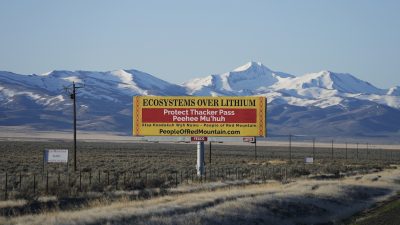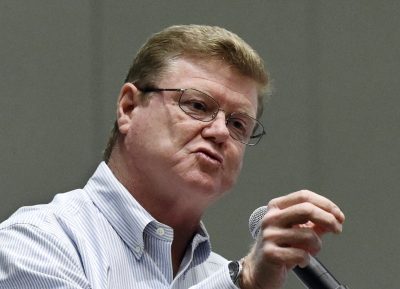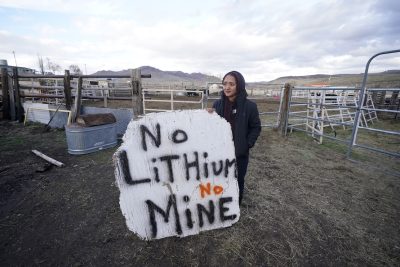
RENO, Nev. (AP) — Environmentalists, tribal leaders and others have fought for years against lithium mining ventures in Nevada. Yet opposition to mining one particular desert tract for the silvery white metal used in electric car batteries is coming from unusual quarters: space.

An ancient Nevada lakebed beckons as a vast source of the coveted element needed to produce cleaner electric energy and fight global warming. But NASA says the same site — flat as a tabletop and undisturbed like none other in the Western Hemisphere — is indispensable for calibrating the razor-sharp measurements of hundreds of satellites orbiting overhead.
At the space agency’s request, the U.S. Bureau of Land Management has agreed to withdraw 36 square miles of the eastern Nevada terrain from its inventory of federal lands open to potential mineral exploration and mining.
NASA says the long, flat piece of land above the untapped lithium deposit in Nevada’s Railroad Valley has been used for nearly three decades to get measurements just right to keep satellites and their applications functioning properly.
“No other location in the United States is suitable for this purpose,” the Bureau of Land Management concluded in April after receiving NASA’s input on the tract 250 miles (400 kilometers) northeast of Las Vegas.
The bureau has spent nearly three years fighting mining challenges of all sorts from conservationists, tribes, ranchers and others who want to overturn approval of a huge lithium mine in the works in northwest Nevada near the Oregon line.

In December, the bureau initiated a review of plans for another lithium mine conservationists oppose near the California line where an endangered desert wildflower grows, about 230 miles southeast of Reno.
In Railroad Valley, satellite calculations are critical to gathering information beamed from space with widespread applications from weather forecasting to national security, agricultural outlooks and natural disasters, according to NASA, which said the satellites “provide vital and often time-critical information touching every aspect of life on Earth.”
That increasingly includes certifying measurements related to climate change. Thus the Nevada desert paradox, critics say.
Although lithium is the main ingredient in batteries for electric vehicles key to reducing greenhouse gasses, in this case the metal is buried beneath land NASA says must remain undisturbed to certify the accuracy of satellites monitoring Earth’s warming atmosphere.
“As our nation becomes ever more impacted by an evolving and changing environment, it is critical to have reliable and accurate data and imagery of our planet,” said Mark Moneza of Planet Labs, a San Francisco-based satellite imaging company that has relied on NASA’s site to calibrate more than 250 of its satellites since 2016.

A Nevada congressman introduced legislation earlier this month seeking to revoke the bureau’s decision to withdraw the land from potential mining use. Republican Rep. Mark Amodei told a House subcommittee last week that the decision underscores the “hypocrisy” of President Joe Biden’s administration.
“It is supposedly a goal of the Biden Administration to boost the development of renewable energy technology and reduce carbon in our atmosphere,” Amodei said. “Yet they support blocking a project to develop the lithium necessary for their clean energy objectives.”
The Carson City, Nevada, company holding most of the mining claims, 3 Proton Lithium Inc., had not submitted any formal project plans in 2021 when NASA requested the land withdrawal. But the firm claimed to have done extensive research in anticipation of future plans to extract the brine-based lithium resource it said is one of the 10 largest deposits in the world.
Chairman Kevin Moore said the tract’s withdrawal likely will prevent his energy company from pumping the “super brine” from about one-third of its claims there, including the deepest, richest deposits holding about 60% of the site’s value. He joined Amodei in testifying last week before the House Resources Subcommittee on Mining and Mineral Resources.
“This project is a vital part of transitioning to a green economy, creating good-paying American jobs, combating climate change, ending America’s over-reliance on foreign adversaries and securing a domestic supply chain for critical and rare earth minerals,” Moore said.

Other opponents of BLM’s move include James Ingraffia, founder of the energy exploration company Lithium Arrow LLC. He told the bureau in earlier public comments that by establishing obstacles to Railroad Valley lithium mining, it was undermining efforts to combat climate change.
“Essentially, your actions are boiling down to, ‘There’s a problem that we want to keep worrying about but NOT allow to be solved,’ ” he said. “It’s self-contradictory.”
3 Proton Lithium insists its brine-pumping operations would cause little if any disturbance to the land’s surface. But NASA doesn’t believe the risk is worthwhile.
The area’s unchanged nature has allowed NASA to establish a long record of images of the undisturbed topography to assist precise measurement of distances using the travel time of radio signals and assure “absolute radiometric calibration” of sensors on board satellites.
“Activities that stand to disrupt the surface integrity of Railroad Valley would risk making the site unusable,” Jeremy Eggers, a spokesman for NASA’s Goddard Space Flight Center in Greenbelt, Maryland, told The Associated Press.
“The ultimate decision was to protect Railroad Valley, which in turn protects the critical scientific data that multiple economic sectors rely on,” he said in an email Thursday.
Railroad Valley, in the Tonopah Basin, is approximately 80 miles long and up to 20 miles wide. The valley contains four Wildlife Management Areas and neighboring communities include Currant, Crows Nest, Green Springs, Lockes and Nyala.
By SCOTT SONNER, Associated Press.
Copyright 2022 The Associated Press. All rights reserved. This material may not be published, broadcast, rewritten or redistributed.